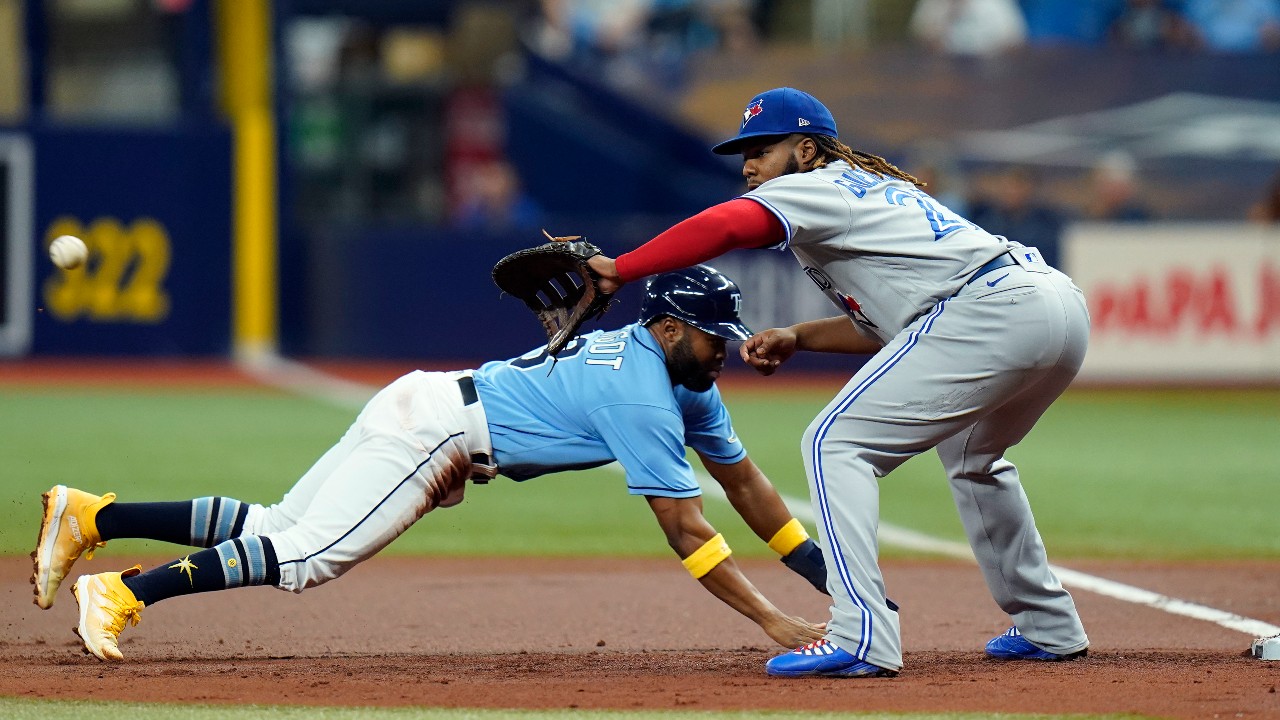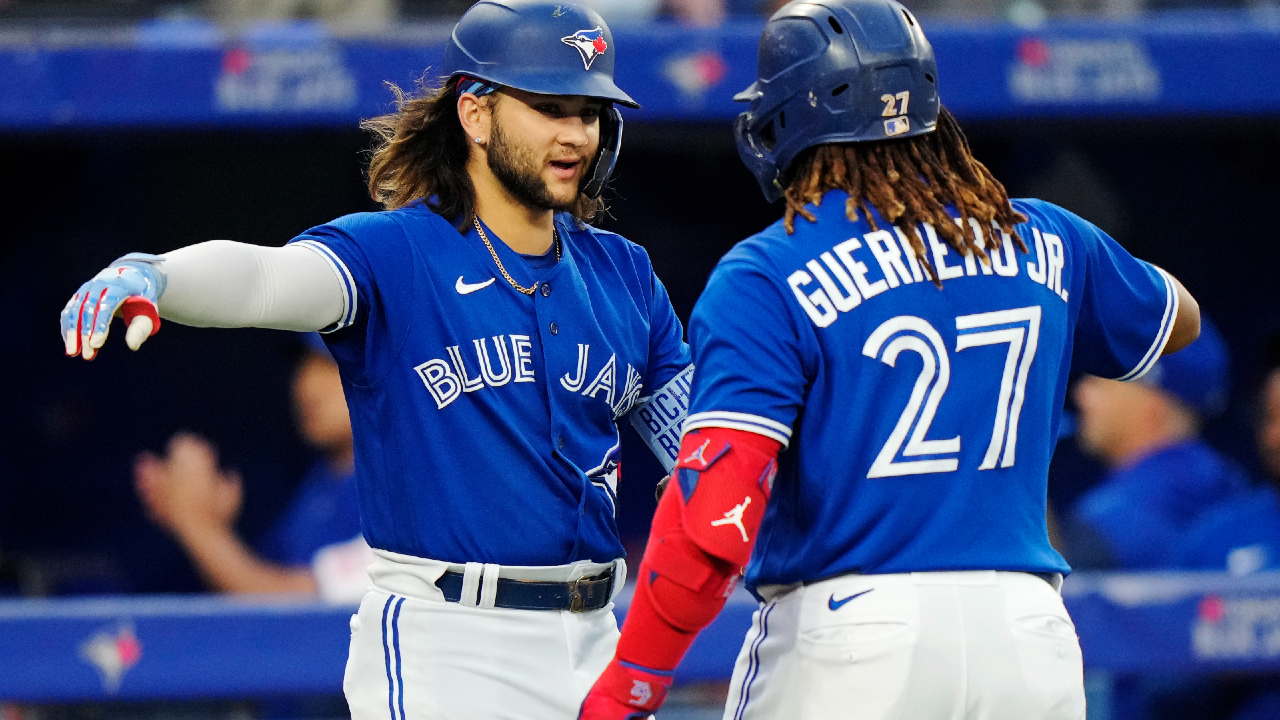
DUNEDIN, Fla. – Catchers do a lot of heavy lifting during spring training. There’s the bulk work of handling bullpen sessions for the dozens of pitchers in camp, the need to learn each hurler’s preferences and tendencies, reps to hone skills receiving, blocking and throwing, plus working to lock down their own timing at the plate.
As if that wasn’t enough, the next six weeks are also set to serve as a crash course on Major League Baseball’s incoming rule changes, for catchers and everyone else, too. Between a 15-second pitch clock, limits on infield shifts and bigger bases, the industry is bracing for a trying period of adaptation to what should be a significant reshaping of how the sport is played.
“All the new rules are going to impact how I do things,” said Toronto Blue Jays catcher Danny Jansen. “The shifting will definitely lead to more hits. The clock is going to be something that will take a little bit of time and (require) more focus on getting on the same page as the pitcher. Obviously, there’s going to be way more stolen-base attempts this year. Even right there, I’m trying to alter my stance to do a little bit more blocking and throwing out of a similar position. For years prior, I’ve kind of got caught in a somewhat different stance once in a while. It’s already changed the way that I’m going to be setting up.”
Jansen isn’t alone in preparing for this new baseball world and finding ways to acclimate as quickly as possible is permeating almost everything the Blue Jays are doing this spring.
Manager John Schneider points to “some constraints” the club has built into its preparatory work, be it in bullpens, live batting practice or the taking of grounders. Think side sessions with timers or chaotic infield drills to help players get used to thinking differently on the fly.
There’s no time to waste because once exhibition games later this month, the new rules will be in play “so guys can get a feel for it,” he added.
The spring schedule also provides a month of consequence-free experimentation on how to take advantage of the new moves, as well as a period of intelligence gathering on ways rivals plan to deploy their roster.
Everyone will be watching everyone while wondering what the Los Angeles Dodgers will do that everyone else tries to copy, and just how off-the-menu the Tampa Bay Rays go.
“I’m interested to see what the coaching will be or how you can strategize certain situations,” said Blue Jays centre-fielder Kevin Kiermaier. “I’ve got a lot of questions, as well.”
Many others do, as well, so with that in mind, let’s take a look at what to expect.
The Pitch Clock
Schneider calls this “the big one to get used to,” and rightly so, given the spinoff effects caused by the 15-second clock.
The way it works is that once the pitcher gets the ball back, a countdown is triggered to his next pitch. Once started, a hitter must be in the batter’s box and alert to the pitcher by the eight-second mark and the pitcher then must either begin his motion if pitching from the windup, or start his leg lift throwing from the stretch, before the timer hits zero.
A violation by the pitcher results in an automatic ball being called while a batter violation is an automatic strike.
Pretty straightforward, but it’s in the ample nitty-gritty that things get interesting.
Hitters, for instance, get one time-out per plate appearance while pitchers are granted two disengagements, pickoff throws included, from the mound. The latter is lush with opportunity for clever clubs.
Teams will have to be judicious in when they throw over because once a pitcher is out of disengagements, any pickoff attempt that doesn’t result in an out on the bases will be ruled a balk. A clever baserunner can try to draw two throws before taking off with a lessened threat of being picked off, or simply attempt to taunt the pitcher to a point of distraction. First and third situations could be particularly chaotic.
“A speed guy like me, I’m already in a pitcher’s mind before these rule changes,” said Kiermaier. “Now, if I’m hitting eight or nine and we’ve got George (Springer), Bo (Bichette), Vlad (Guerrero Jr.) coming up, I want them to get as many fastballs as they can. If I see a pitcher wanting to just keep spinning things, I’m going, and now I’m in scoring position and all they have to do is hit a single. Our odds of scoring get that much greater. So, I’m going to try to be a threat in as many ways as I can be.”
To that end, Jansen expects slide steps to be “even more of a focus than usual,” to get the ball to the plate faster. He’s looking to refine his set-up in anticipation of more throws to the bases, including throwing behind runner, or backpicking, more often.
“That’s going to be part of it, just shortening secondary leads,” said Schneider. “That’s the whole goal of (throwing behind the runner), it’s not to get somebody out. If you do, that’s kind of a bonus. … Catchers are going to be active around the league. I know our catchers are going to be active. We’ve talked about it and it’s going to be fun to watch how teams try to roll out their strategy.”
Umpires will be on the watch for little ways to circumvent the clock, be it catchers holding the ball longer before returning it to the pitcher to delay the timer’s start, or hitters claiming to have something in their eye or pitchers using motion in their delivery to avoid a violation.
On that front, a requirement that pitchers throwing from the stretch must assume and hold the set position before lifting their front leg very much applies to Blue Jays ace Kevin Gausman. That’s an old rule that will be more consistently enforced this season and the right-hander, called for a balk during a pivotal matchup against the Baltimore Orioles last September because of the way he gently rocks before coming set, has been making adjustments to ensure he’s in compliance.
“Pete (Walker, the pitching coach) has been awesome being in touch with Kev and working through a few minor changes with what he’s going to be doing,” said Schneider. “He’ll continue to use spring training to iron it out, but he’ll be well within the rules of a full body stop and hopefully not having another episode where he’s getting a little bit heated at an umpire.”
Another area of experimentation will come with the PitchCom system introduced last year, which allowed catchers to call pitches with a push-button wearable transmitter. This spring, pitchers can also wear a transmitter to call pitches instead of just receiving signals, a change approved for the exhibition schedule but not yet the regular season.
Limits on Infield Shifts
Remember all those times what looked like a sure hit off the bat became an out into a defensive shift? Kiermaier certainly does, which is why he said, “I think there’s going to be a lot of lefty hitters out there very happy that long line drive or grounder that you crush to the second baseman isn’t going to be an out anymore.”
Teams must now deploy two infielders on each side of the diamond when the pitch is released, so the shortstop, for example, can’t take off with the windup to try to get into a shift position. Infielders also must have both feet on the dirt clear of the outfield grass as the pitcher begins his motion.
The limitations do not, however, extend to outfielders, who can set up where they please. That makes a two-man outfield a possibility for clubs who want to be daring, Major League Baseball believing that the risks of extra-base hits is too great for the practice to become commonplace.
“We’ve talked about that,” said Schneider. “We have three very, very, very capable defenders in the outfield on any given night with (Daulton) Varsho, KK and George. That really comes down to a select handful of hitters that you would really try to target, if that’s even an opportunity. Two-man outfield sounds funny, but like anything, you’re working around the strengths of your roster and if there’s an opportunity that we think can help us based on what their skill set is, we’re going to look at we’re going to look to do it. We’ll see how it rolls out.”
Additionally, there’s no position-swapping absent a player substitution once an inning begins, meaning an infielder can’t play shortstop for one batter and then second the next.
Teams can use replay challenge for shift violations, which are penalized with an automatic ball. If a ball is put into play and everyone reaches safely, the play result stands, but if any other play results from a pitch with infielders in violation, the batter’s manager can decline the penalty and accept the result of the play.
Enlarged Bases
The least invasive of the three rule changes, bases are growing to 18-inches-by-18-inches instead of 15-by-15. Due to the way they’ll be positioned, that reduces the distance from home to first and third to home by three inches, and 4.5 inches first-to-second and second-to-third.
In minor-leagues testing, bigger bags reduced what Major League Baseball described as injury events on the bases by 13 per cent from 2021-22, and there’s no arguing around increased safety.
First basemen, in particular, should benefit from the extra space to reach for errant throws without fear of colliding with runners and the same holds true for pitchers sprinting to the bag to cover the bag.
The impact on baserunning is less clear as the success rate on stolen bases climbed 1-2 per cent in triple-A testing during the 2021 season, although coupled with the limits on pickoff attempts, elite baserunners will likely find ways to capitalize.
“It opens up the door for guys like Matt Chapman or Varsho to add on a little bit,” said Schneider. “Vladdy had eight stolen bases last year. You play into it a little bit and you try to be a little bit proactive with the rules that are out there. We definitely have the personnel that can do that. It’s something I’ve always liked, not just stealing bases but just being aggressive first-to-third first, first-to-home, second-to-home. Those are the things we’re going to be focusing on.”







